This four-image mosaic comprises images taken from a distance of 28.4 km from the centre of Comet 67P/Churyumov-Gerasimenko on 3 January. The image resolution at this distance is 2.4 m/pixel and the individual 1024 x 1024 frames measure 2.5 km across. The mosaic is slightly cropped and rotated and measures about 4.4 x 4.2 km.
Because rotation and translation of the comet during the imaging sequence make it difficult to create an accurate mosaic, always refer to the individual images before drawing conclusions about any strange structures or low intensity extended emission.
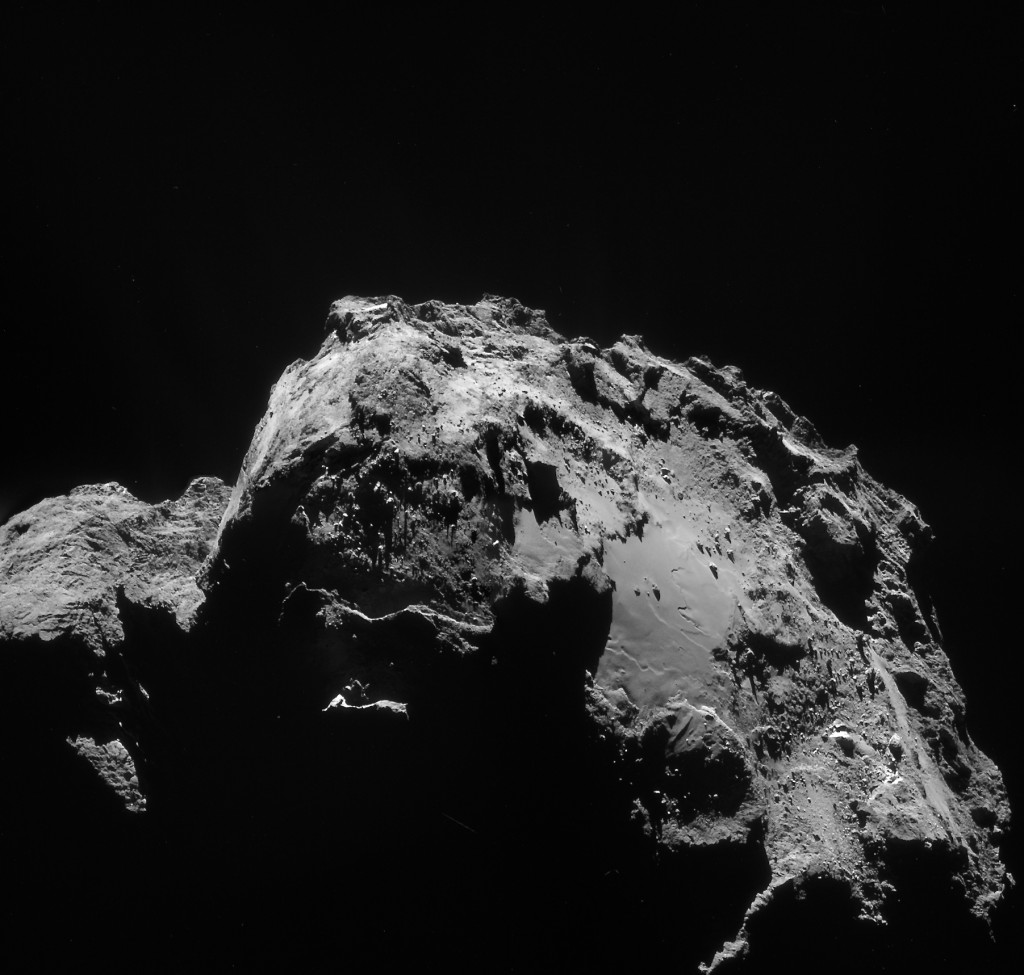
Four-image mosaic of Comet 67P/C-G comprising images taken on 3 January 2015. Credits: ESA/Rosetta/NAVCAM – CC BY-SA IGO 3.0
The mosaic shows a great view across the Imhotep region, which includes the Cheops boulder on the larger of the two comet lobes. The name of this region was revealed during the AGU conference in December (see the 17 Dec post). The smaller of the comet’s lobes is situated to the far left of the mosaic.
The illumination conditions contribute to the interesting view of the features standing out against the shadowed foreground, close to the centre.
Some of the streaks and specks seen around the nucleus will likely be dust grains ejected from the comet, captured in the 4.3 second exposure time.
A montage and the four individual 1024 x 1024 frames are provided below:

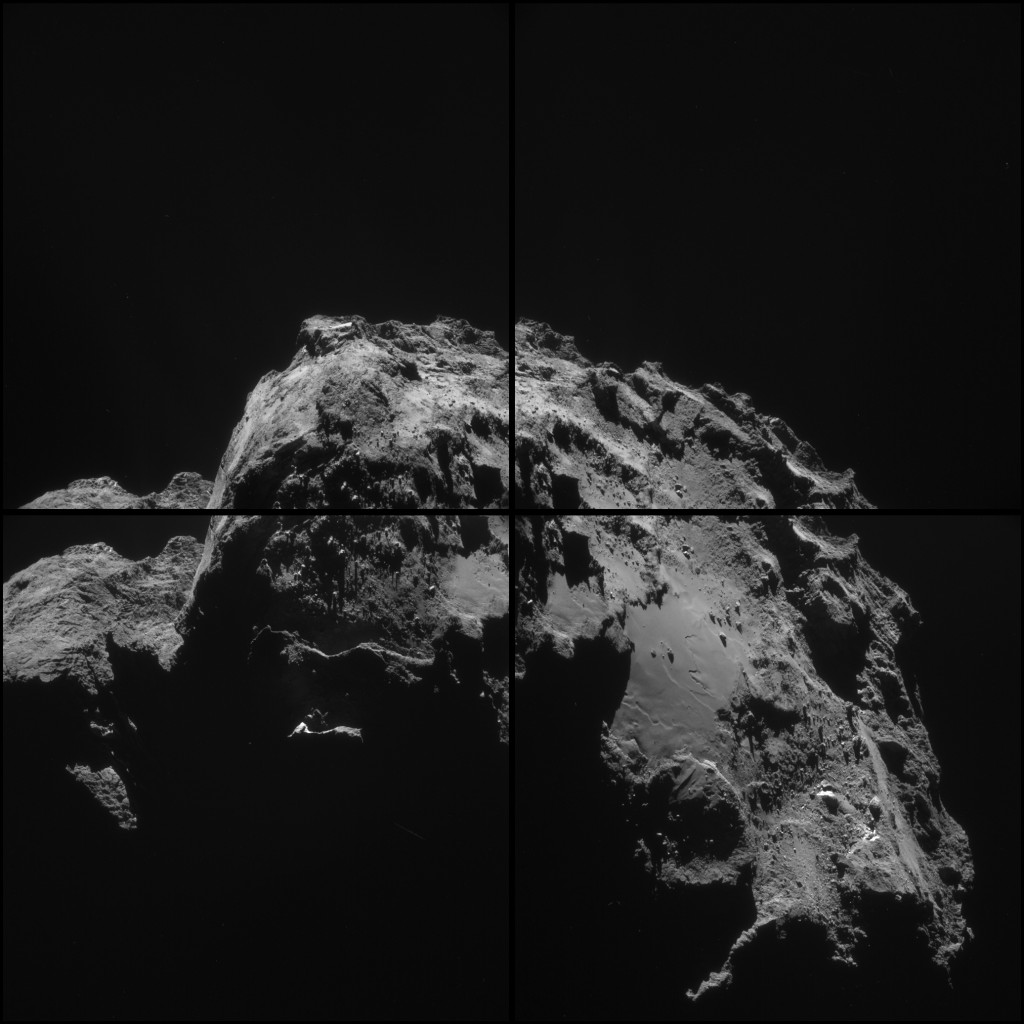
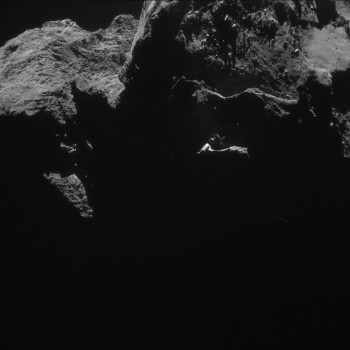
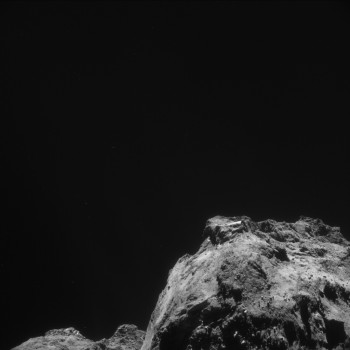
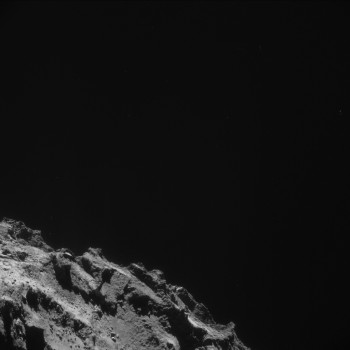
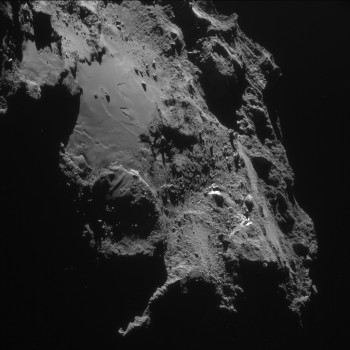








Discussion: 40 comments
Looking at these and other images, I have the impression that the dominant kind of encounter in the early solar system must have been a very low energy impact. You can hardly call it an impact, Imagine many tiny grains of material orbiting very closely together. And even after boulder-sized objects formed, even then the low energy encounters must have been far more numerous than disruptive cratering type events. The spectacular smashing encounters must have come late in the accretion process, probably not very significant until very substantial massive objects had formed.
I have similar impressions about these images but I see a lot of other stuff happening here. There are a lot of plate-like or shale like plate features that in some parts of the comet are layered. The boulders and dusty smoothness seem to imply a gradual and gentle encounter or even multiple re-encounters that you mention, but the plate like features seem to imply other activities perhaps melting and freezing cycles generating multiple ice-rink type layers. While the inverted mushroom cap features are suggestive of more energetic collisions. Some of these flowers or inverted mushroom caps are sitting on sculpted pedestals that may be less dense than the more solid ice-rink stuff on top. Other areas almost resemble huge crystalline formations. I would imagine the stuff that didn’t get stuck to these early bodies received very slight gravity boosts that flung them off some hitting other similar bodies, some getting even more gravity boosts. They seem to have come from the same initial shotgun blast, in any event.
Hi H. NAVCAM team 🙂
Speculation being the game:
Re-taking the idea of a comet full of voids, i would like to think that their size are not random, but a natural multiple of layer separation, with 1 being the most common void size.
By highly debated phenomena, those voids get pressurized.
That pressure causing material migration. That material migration fabricating the Bob’s ducts we have seen a lot of times, surfacing as ‘bright’ material at the middle of the plains and, -when strongly compact ‘sintered’- becoming ‘needles’ punching the surface.
……
Robin’s ‘haze’ seems omni-present.
Hi Logan,
Unfortunately for your speculation, the initial CONSERT data have shown “very little or no scattering from internal surfaces” and thus ruled out the possibility of any voids inside the comet.
That is inaccurate.
On a small number of paths which lie rather close to the surface of the ‘head of the duck’ *only*, it rules out a substantial fraction of voids *on a few metre scale*. With its 10MHz bandwidth, CONSERT cannot resolve finer scale structures. Nothing can be deduced about fine scale in homogeneity.
Although some data was retrieved on similar ‘close to the surface’, tangential paths which traversed the duck body, Central Valley, then duck head, the signal to noise was too poor for much to be made of it.
Yes. For instance, cavernous voids (I think I was flagging the possibility a few months ago) are ruled out, thus “porosity” is more likely at a more conventional mm scale or plausibly also at the submetre to metre scale.
Inaccurate in what way?
The sample of high-confidence-level paths shown in Wlodek Kofman’s presentation (https://virtualoptions.agu.org/media/P34B-01.+Rosetta+2014+III%2C+Presented+By+Wlodek+Kofman/0_5fh9qjnj) is indeed small (just 3) and limited to the head of the duck, but he seems confident that they are probably sufficiently representative for him to offer the conclusions he does, however tentative. Ongoing analysis of other acquired path-data will likely confirm the initial conclusions.
Concerning the scale of any possible voids, even with the 10MHz bandwidth he is working with, Kofman quite explicitly rules out the presence of any voids on the paths so far analyzed which could be greater than the “order of the metre to two metre scale”: this is considerably less than the rather vaguer “few metre scale” you claim. Of course, the “metre to two metre scale” constraint in no way rules out the possibility of a total absence of voids, as Kofman himself implies.
As for your claim that the paths presented “lie rather close to the surface of the ‘head of the duck’ *only*”, I can only suppose that you missed the passage where Kofman specifies (from 7:45) that the high-confidence-level signals went through “part of the head”, and more specifically “probably went through 800 metres, perhaps 1 km inside, not more…”. This is already considerably deeper than you claim and truly concerns the *interior* of the head, rather than simply the surface as you apparently seek to imply.
“Soyons précis: le diable est dans le détail”, above all in science.
The paths are shown explicitly and easily derivable from the positions; they are as I describe. Only on those paths is there any data. It scrapes through the edges tangentially, the path which traverses both the edge of the body and of the head probably gives the 800-1000m figure. I looked at his figures in detail.
To me, a void is a void, on any macroscopic scale. The CONSERT data certainly does not mean it is solid in the sense of a lump of rock or solid ice; basically, it doesn’t rule out ‘dirty snow’ – full of voids – 🙂
A few metres, a metre or two, are pretty much synonymous at the level of data we have now.
At 10MHz bandwidth you have, conventionally, a 30nS 10-90 % rise time. The equivalent spatial resolution depends on what dielectric constant we assume; if we take say 4, the equivalent is ~5m; you can get somewhat inside that when your signal to noise is very good, but one metre is pushing your luck; certainly only the ‘head only’ data could get near that. (It only depends on the square root of the dielectric constant, so changes don’t alter the result that fast.)
Partly semantics, partly it depends which bit of data; the very best bits might push down towards a metre or two.
@ Prof Harvey Rutt
“The CONSERT data certainly does not mean it is solid in the sense of a lump of rock or solid ice; basically, it doesn’t rule out ‘dirty snow’ – full of voids.”
Conversely, the CONSERT data certainly does not mean it is ‘dirty snow’ – full of voids. And it doesn’t in any way rule out its being a lump of rock or solid ice.
I understand your insistence on this point since if the standard theory is to be adequately defended, the sacrosanct 0.4g/cm3 density figure now absolutely requires the interior to be made of “dirty snow – full of voids”. We now know that if there are indeed any voids they must be extremely numerous and homogeneously distributed throughout the interior, since the CONSERT data has placed serious constraints not only on their putative existence but also on their maximum hypothetical size (1-2 metres maximum, according to Kofman).
One simply wonders how they got there, if they exist. This externally rocky comet is apparently increasingly being constrained to resemble something like a “choux à la meringue” (the density of which is presumably indeed around 0.4g/cm3…). I don’t buy it.
Just for the record- I’m with Harvey on this one. Cavernous voids are ruled out by CONSERT, Solid rock or ice is ruled out by the DEDUCTION of the density. Anything else is speculation within those constraints.
One of mine vanished somehow.
A ‘mea culpa’; not that anyone noticed.
CONSERT uses a transponding architecture of a somewhat complex type. In *some* cases this would double (improve) the spatial resolution & make ‘a metre or two’ much more justfyable. But its *not* clear to me that factor of two applies to sub code-bit-scale scattering (it might then be root two? Incoherent addition? Not sure.)
BTW, the CONSERT team already know if its high void fraction – even on this limited data, the delays would be *far* higher if it was solid. Unfortunately many of his graphs lack scales & have suppressed zeroes so I cant tell; but he can.
Incidentally, my analogy was one of the bits that make up a croquembouche; ablation seems a very natural way to form that structure, rocky outer, icy inner, as opposed to caramel, choux, & creme chantilly 🙂
@ Harvey
“BTW, the CONSERT team already know if its high void fraction – even on this limited data, the delays would be *far* higher if it was solid. Unfortunately many of his graphs lack scales & have suppressed zeroes so I cant tell; but he can.”
It would be nice indeed if this data were published, to settle the debate one way or the other, once and for all. It’s something I’ve been crying out for ever since the data was acquired.
Yep and we have to understand THOMAS that what we are dealing with is not the possibility of voids really. It is the hope for voids. And what is needed is not just some voids. What is needed in my humble opinion is something in the region of 83% porosity. And here is the reasoning for that assertion. By any reasonable judgement and comparison the nucleus of this comet looks like what would immediately be recognised on Earth as rock, and in my view igneous rock of the basalt type. The expected typical density for rock of this type is around 2.6 g/cc. Yet the measured density is 0.4 g/cc. Lets be generous and call that one sixth of expectation. So five sixths or approximately 83% has to be nothing, or porosity. So even 50% porosity would be a long way from justifying the density.
83% porosity would be immediately recognisable at any fracture and nothing close is seen. The fractures look like solid dense rock.
Igneous rocks in general exhibit among the lowest porosities of any rocks including most basalts. There are however some rare basalts that display porosities up to 20% and these are rocks that have solidified in the presence of gas evolution. And there may be some examples of these (pumice types) with unusually high porosities and low densities in the region of 1. Still 2.5 times higher than our example. So if the nucleus was rock and the density was saved by porosity it would be a unique form of pumice type basalt never previously encountered and still defined by the only way it could have formed, by solidification from the high temperature liquid state.
This temperature factor would not satisfy the believers either. To them it must not be rock. of even the rarest type. So every last attempt will be made to bend things to that, including hopeful interpretation of the limited and inadequate results so far. It can only be loosely packed snow and dust, with no worries about how such a body could maintain its integrity over supposedly billions of years with for at least some of that time a trip round the Sun every 6.5 years.
It should also be noted that all expectation about porosity hinges on the single widely quoted 0.4 figure. Are we to believe that was the only measurement. The fact that it was so unexpectedly low would surely have suggested the need for a few repeats, even if it did not occur to anybody that it might be an interesting idea to take regular and frequent mass measurements as the nucleus progresses around the Sun and back towards the vicinity of Jupiter.
Imhotep, eh? THAT ought to drive the Nutters into a frenzy…
https://images2.static-bluray.com/reviews/835_2.jpg
🙂
–Bill
“I understand your insistence on this point since if the standard theory is to be adequately defended, the sacrosanct 0.4g/cm3 density figure now absolutely requires the interior to be made of “dirty snow – full of voids”. ”
Perceptive and accurate THOMAS. That is the way faith works. Every last shred of possibility has to be clung onto. The alternative is too traumatic especially if the belief has been widely trumpeted. The objective is to retain credibility and self image but in reality the believer just digs him or herself into a deeper abyss.
“Where is the ICE?” has been the cry from some. Bottom right of this image there are two large, tens of metres in size, areas of very bright white material. In fact this image is littered with white objects, even the top of Cheops seems almost completely devoid of dark material now. Right at the top of the image on the body lobe there appears to be a fresh cliff fall with several bright white “Cryoboulders” at the bottom of the cliff face. Its difficult to point to specific areas and compare them to previous images, the different lighting, viewpoint etc., but I get the impression the areas of dust covered surface are definitely reduced with more subsurface showing through.
I think the ‘white’ in the images would actually still be a solid black with image intensity enhancements removed…
there is somewhere an albedo comparison with 4 bodies, an icy moon, earth, mars, and that lump of coal we call p67….
I assure you, if any of the structures or debris you’ve pointed out consisted of ice, Rosetta would have detected it. There is no ice, the comet is solid rock… regardless of the indirectly measured density. The cliffs of the neck region displays the interior of the comet, completely absent of ice or gas pockets, with stratified layers. You’re looking at a rock, likely carved from the surface of a planet in the same manner which material is currently being carved from the comet.
So rock not ice eh. Care to disclose the process that results in the most abundant molecule in the coma being good old H2O?
Ignore the density, ignore the water in the coma, nothing beats non-evidence based science does it?
The dusty top surface is indeed pretty much devoid of ice, the ice sublimated long ago, but that’s only 20-30cm thick. Below that there’s ice and lots of other molecules many carbon based. No wonder the comet is black!
And are we ignoring the dust?
As I remember, Philae determined that temperatures dropped a lot just under the dust. This makes sense. Even in the desert, turn over even a thin rock and it’s much cooler underneath. 20-30cm of dust is actually quite thick. I may be missing something here, but I guess I’m still trying to understand sublimation. Recently there was discovered permanent, “deeply shadowed, and thus perpetually frigid” crater ice on the surface of Mercury that is not sublimating, and ice that remains in craters on the moon that is not sublimating, but here we have ice that’s also in darkness because it’s lying under an insulating dust layer 20-30cm thick on a comet 10 times further from the sun than Mercury that IS sublimating? Has the dust thickness been confirmed? It does look quite thick at the neck where so much of the coma activity seems to be originating. If the dust is 20-30cm thick there, or thicker, can’t imagine any heat at all really penetrating that deep. Even now the sun is just a pin prick in the sky, yet there is a lot of activity at the neck. If sublimation is happening, seems like it would be most active where the dust is thinnest.
SS, the point is that the areas on Mercury and the Moon are in “permanent” shadow, other parts of the craters that do receive any sunlight have no ice. I agree the thermal insulation of the dust should slow the sublimation rate considerably and the temperature measurements made by MIRO of the few centimetres below the surface do show a sharp decline. It iwould seem strange then that in Bill’s nicely enhanced image the majority of the activity is from dusty areas.
The activity we can actually see is in fact dust being removed from the surface by sublimation gases, in areas where ther is very little or no dust, the sublimation activity can not be seen. Given the amount of Water, CO2 and other volatiles present in the coma, the activity in these areas is, as you suggest, probably a lot higher. Once again the OSIRIS instrument with its Infrared capabilities ought to be able to show this along with ALICE using UV.
Exactly, Robin. That’s my point, the theoretical ice under the P67 dust is also in permanent shadow. Philae has already confirmed much lower temperatures just under the dust, and the amount of sunlight (and heat) that P67 was getting when we first saw all the activity at the neck was (and still is) extremely minute, and certainly not enough to penetrated down through a thick layer of dust. And for sublimation to cause the “explosive” jets we see coming off the neck, a relatively large amount of heat would have to penetrate not only through the thick layer of dust, but also through the crusty layer of hard non-sublimating material where the highly improbable, theoretic single nozzle resides. It’s all just extremely improbable. At some point I think the data will require that the question shift to, “Are there alternative ways that atmospheric H2O can be produced other than evaporation/sublimation?”
You are wondering, how heat could penetrate the dusty layers. Well, a lot of the smooth structures on the surface can be understood as results of formerly fluidized dust. As soon as this dust is fluidized again by first sublimating gases, it suddenly behaves like a turbulent fluid and has therefore an excellent heat transfer, easing the further penetration of heat strongly. Consequently the energy input into the “solid rock” below the dust would increase rapidly after a first activation, possibly explaining the intense dust-jets at these places.
I based my speculation on the results given at the AGU meeting. An area of very bright white “cryorock” that looked to be a recent cliff fall in the Imhotep region was shown to have the UV signature of Water Ice. I agree in reality these areas are still virtually black, but there does seem to be a correlation between these bright areas and ice.
The measured density still seems to be in dispute. Perhaps it should be pointed out that Rosetta performed a density measurement on the asteroid Lutitia earlier in the mission using the same method. The density was found to be about 3.4 g/cm^3. This a value slightly higher than rock, but consistent with the higher Iron/Nickel content of types of rocky meteorites found on Earth. The method and result for measuring the density of 67P has thus been shown to be valid and it is NOT made of rock.
I thought the 67P density value was derived from mass calculated from orbit, volume from OSIRIS and/or other instrument mapping to arrive at density value.
I didn’t know they could get a density value from a 3k km flyby (Lutetia)?
TIA for any reply
Hi Jon. Took me a while to find it again but here is link to the publication.
https://sci.esa.int/rosetta/49547-p-auml-tzold-m-et-al-2011/
Thanks for the new photos.
And one question: Has already someone identified
surface differences when comparing photos from
August/September/October with more recent ones?
Does someone have software to make such comparisons
automatically?
Cheers, Ingo.
I have been working on a series comparative images since the beginning of the mission. See:
https://univ.smugmug.com/Rosetta-Philae-Mission/Rosetta-Comparative-Series/
I’m not using software, it’s a just a matter of sitting down and picking through the images “pixel by pixel.”. Ouch.
–Bill
And mulling over Ingo’s question a bit more… I’m sure that a hot-shot cartographer could “reproject” these images and make them match on a 1:1 basis. The software exists as do the skills. Me, I’m just a geologist and I’m satisfied to get the images “close enough”.
For example, today’s new image of the Imhotep Plain. Compared to an earlier image, the scales are a little different, but the new image is looking at a much flatter angle on the top and especially the top right corner. I did slightly “stretch” the image by resizing it more in the “y” direction than the “x” direction, but that is all I care to do in most cases. I’ve did a little work on doing an actual “perspective correction” for my in-house work, but rarely for my public offerings.
–Bill
Keep in mind that ultimately only have a few images are available to us and most from a camera that is made for navigation (NAVCAM), not imaging at a high resolution. So even if you think that you can spot changes it can be difficult to be certain as to whether it is a real change or simply an illusion due to camera angle, lightning conditions, resolution etc. The comparisons Bill Harris posted is a good start, just be careful about drawing too many conclusions from them.
This is a comparison of the Imhotep (informally named “Equatorial”) Plain of the Larger Lobe: OSIRIS image 6 August 2014 and NAVCAM image 3 January 2015. Note that there are differences in the lighting angles and viewing geometries. The scale is adjusted to approximately 2.5 m/Pixel.
https://univ.smugmug.com/Rosetta-Philae-Mission/Rosetta-Comparative-Series/i-CVJnvss/0/L/_compar_osiris_6aug14_navcam_3jan15–imhotep-L.png
–Bill
I think, based on your efforts, it is going to be tough to nail down albedo changes. They would have to be very dramatic to rise above the effects of changing lighting and viewing angles.
Ducky is sweating like a race horse by now. But she shouldn’t.
There is an elephant in the room, and is energy sinking.
If ice is almost not at the surface then it is in the inside.
But, how can this ‘sintered’ mini world drain energy down from the surface?
Breathing?
a few more highlights from the UnmannedSpacecraft.com Rosetta threads:
Malmer’s 3D model of 67P with textures applied (OBJ & DAE formats):
https://www.unmannedspaceflight.com/index.php?showtopic=7896&view=findpost&p=216661
What appears to be (?) three ‘boulders’ moving across the surface of the comet:
https://www.unmannedspaceflight.com/index.php?showtopic=7896&st=1170&p=216807&#entry216807
Refined final Philae position from conference presentation:
https://www.unmannedspaceflight.com/index.php?showtopic=7896&view=findpost&p=216557
Files/instructions to use ESA’s 67P model & SPICE position/rotation data for Rosetta, Philae & 67P in Celestia:
https://www.unmannedspaceflight.com/index.php?s=&showtopic=7883&view=findpost&p=216070
Instructions/tips for modeling Rosetta, Philae, 67P in (free) STK software, using ESA SPICE data for position rotation, etc:
https://www.unmannedspaceflight.com/index.php?showtopic=7896&view=findpost&p=216326
Some of you may know, but some may not, about the unmannedspacecraft.com forums about the Rosetta mission. Below are just a few of the interesting things related to Philae’s landing that have come out of those discussions (heavily biased towards the things I’m interested in or have worked on, of course!):
* 3D visualization of Philae’s ‘wild ride’ across the surface of 67P, from Philae’s point of view, featuring Malmer’s detailed 3D model, hi-res textures, etc.:
https://www.youtube.com/watch?v=agmmOT8N-bk
* Possible/very probable location of the famous Philae post-landing ‘blur’ photo on 67P’s surface:
https://www.unmannedspaceflight.com/index.php?showtopic=7896&st=1140&p=216673&#entry216673
https://www.unmannedspaceflight.com/index.php?showtopic=7896&st=1153
* Quick blink compare of the ‘blur’ image vs 67P surface where it matches:
https://www.unmannedspaceflight.com/index.php?act=attach&type=post&id=34702
* Nice deconvolution of the ‘blur’ image by user Machi:
https://www.unmannedspaceflight.com/index.php?showtopic=7896&view=findpost&p=216419
* Philae’s journey from Rosetta to 67P, visualized in 3D based on ESA SPICE data for spacecraft & comet position, orientation etc:
https://www.youtube.com/watch?v=Tw0CnfEwqGQ&feature=youtu.be
I think it is possible to understand the smooth flat surfaces as a result of fluidization of dust by gas-streams of sublimating water ice. Due to the low gravity low gas speeds äre sufficient to reach the fluidization. Since fluidized dust behaves like a fluid it flows down the hills and forms kind of shallow lakes. Now that acticity is still lowthe düst doesn’t move. But we can expect that fluidization beginns when the comet is closer to the sun and the surface becomes more active. In this case some of the step-structures in the smooth flats shouls disappear or change.
I must have missed the “Imhotep” naming? the truth is, of all those new names I prefer “perihelion cliff”, and at first I thought IMHOTEP was an acronym like: TransEquatorial Propagation -IMHO!
Agreed, Norbert.
The dust is clearly fluidized, probably by a _number_ of processes and flows as a fluidized bed. This is noticeable at the Agilkia landing site (see
https://univ.smugmug.com/Rosetta-Philae-Mission/Philae ) and is especially prominent at the “Imhotep Plain” on the larger lobe.
–Bill
Emily, a query, if it’s possible to make one.
We have a slowly refined value for the overall density.
But, given the now very extensive orbit data, is there any ability to retrieve density vacations within 67P?
This is certainly done for bodies like the moon, but will be far harder for 67P with its irregular shape. But it may be possible at some level, if only at a ‘consistent with the body being uniform plus/minus x percent’ or whatever statement; but given the precision navigation, maybe more than that is feasible.
Do you know if any such data exists or may be forthcoming? Aside from CONSERT, the only way to look ‘deep inside’ 67P.
Apologies to all you specialists commenting on this object, but your speculations about this phenomena sound like gibberish. You speak of ice and water – yet none has been found. You speak of ‘fluid dust’ and of a remarkable occurrence wherein 2 solid objects, travelling at massive speed, apparently fused to form a ‘rubber duck’ shape, instead of smashing to a million pieces.
No scientific explanation as to how such an occurrence could happen has been put forward….
Your commentary and speculation make it almost impossible for the lay person to understand what you are talking about. What, for example, are voids?
Presumably this ‘comet’ is supposed to be millions of years old??? Yet the object was unknown before 1969. Did it simply float into our solar system? How old is the object?.